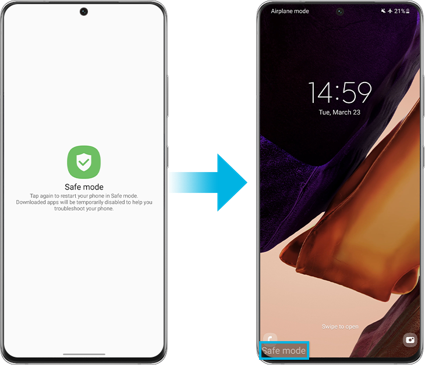Samsung phone unexpectedly powers off
Being unexpectedly interrupted, especially while you are in the middle of something, maybe annoying. Find out what's causing the shutdowns and how to stop them from happening again by following along.
If your phone's battery is running low, features or apps that need more power may force the device to shut down unexpectedly. This feature is intended to keep the battery safe.
- Remove any covers or accessories that may interfere with the device's buttons.
- Examine the Power or Side keys for regular movement. When you push the button, there should be a small but definite clicking sound. If the key becomes stuck, it may trigger unexpected shutdowns.
Only use an original Samsung charger and USB cable.
The auto-restart feature helps to keep your Samsung Galaxy device in good running condition by restarting your phone periodically. It can be enabled and disabled as needed and will only occur when the device is not in use.
- Certain apps might cause your phone or tablet to freeze, crash, or lag. Some programs can even interfere with camera performance, create audio problems, and disrupt network connectivity.
- Safe mode disables all downloaded applications and runs just the original software that came with your phone or tablet, allowing you to establish if the problem is due to an app or the phone or tablet itself.
If the problems do not emerge when in Safe mode, they are the result of downloaded software that should be deleted.
Note: If you have a security feature enabled on your phone or tablet, you will be prompted to input your credentials when the device reboots.
First, open the Power menu:
- On devices with a regular Power key, press and hold the Power key until the Power menu is displayed.
- On devices without a power button, swipe down with two fingers from the top of the screen to open the Quick Panel. Tap the Power icon at the top of the screen.
Touch and hold Power off until the Safe Mode icon is displayed. Tap Safe mode to start your device in Safe mode. If you've entered Safe mode successfully, you'll see Safe mode displayed at the bottom of the screen.

Use the phone or tablet to see if the issue has been fixed. If the phone or tablet is operating normally, a recently installed app was most likely causing the issue.
- If the issue is gone in Safe mode: One of your recently downloaded apps was likely the cause of the problem. You need to proceed to Step 4.
- If the issue still exists: Downloaded apps may not be the cause of the problem. You may need to reset the phone or tablet to the factory setting.
One by one, uninstall any apps you downloaded just before your phone or tablet began having the issue.
After uninstalling each app, restart the phone or tablet and check if it is working normally.
After uninstalling the app that caused the issue, you can reinstall the other safe apps you just deleted.
First, open the Power menu:
- On devices with a regular Power key, press and hold the Power key until the Power menu is displayed.
- On devices without a Power key, swipe down with two fingers from the top of the screen to open Quick Panel. Tap the Power icon at the top of the screen.
Tap Power Off to turn off the device. Wait until the phone or tablet completely turns off, and then press the Power key again to turn it on. See if the issue has been resolved.
Note: You may need your Samsung account password or Lock screen password when resetting your phone or tablet. All your data will be erased. However, before resetting your device, you can use Smart Switch or a cloud account to back up your data.
- Make sure to back up your phone or tablet. All data and settings will be erased.
- Write down the username and password for the account that you used to back up your data.
- We recommend having your phone or tablet plugged into the wall charger during the reset process because it may take up to an hour.
- If you have encrypted the SD card inserted into your phone or tablet, make sure to decrypt it before the reset. Navigate to Settings, search for and select SD, and then tap Decrypt SD card.
Go to Settings. Search for and select Factory Data Reset. Tap Factory data reset again and then press Reset. Follow the on-screen prompts to complete the reset. You may need to enter your Samsung account password or Lock screen password. The phone or tablet will reboot.
- You can also follow the steps from
Settings - General Managemen - Reset - Factory Data Reset.

When the phone or tablet reboots, it will have its default factory settings.
Now you will need to go through the initial setup to finish setting up the phone or tablet. The phone may require you to enter your Samsung or Google account information to complete the setup
Note: If you are still experiencing network service issues with calls, SMS or MMS messages, network signals, mobile data, or hotspots after resetting the device, you may need to contact your carrier.
Before installing any apps, make sure that your phone or tablet is functioning normally.
If you are still encountering any issues, please visit a Samsung Service Center.
Note: For further assistance or questions, please Contact us.
Is this content helpful?
Thank you for your feedback!
Please answer all questions.















